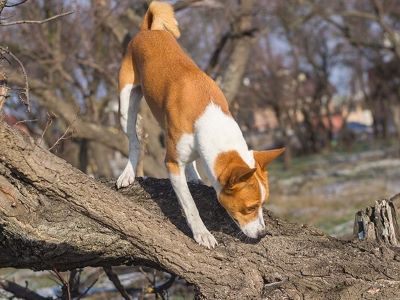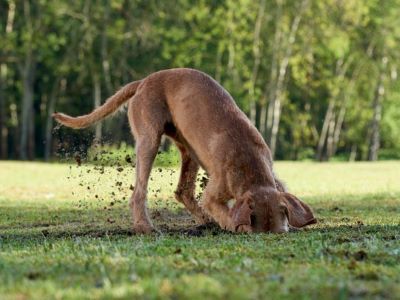Dogs tend to lick and eat their surroundings which makes them the direct hotspot to attract the worms. If your dog eats the snail or any other insect then they are likely to develop infection. This might make you think that is it possible that there can be lungworm in dogs?
Once rare lungworm in dogs has become prevalent in dogs. If left untreated this condition may prove to be fatal.
So, let’s understand what is lungworm in dogs and what can we do to prevent it.🚫

Lungworm in Dogs?
Lungworms are parasitic worms that can infect the airways and lung tissue of dogs. Dogs can get lungworms from infected snails and slugs. When the dog eats them, the lungworm larvae begin their developmental phase🔁 inside the body.
Dogs can get lungworms from infected snails and slugs. When the dog eats them, the lungworm larvae begin their developmental phase inside the body. They are often found in the heart and blood vessels, then moving towards the lungs where they can cause a range of health problems.❤️🩹
Dogs might accidentally consume these infected slugs or snails while playing in the garden or during outdoor activities.🐶 Additionally, lungworm can be transmitted through infected faeces, so dogs can become infected by licking or sniffing contaminated areas.

Multiple species of worm parasites, including roundworm (nematode) and fluke (trematode)[1].
What Are the Symptoms of Lungworm in Dogs?
Puppies are often more affected by lungworm infection than adult dogs. Symptoms may vary as per the individual dog and number of warms. Let’s see some of the symptoms by Krista Williams from VCA Hospitals🏥:
- Persistent coughing is one of the most common signs of lungworm infection. The cough can be dry or moist and may get worse during exercise or excitement.
- Dogs with lungworms may experience difficulty breathing or show signs of heavy breathing, especially during physical activity. Infected dogs often appear lethargic, tired, and less active than usual.💤
- Unexplained weight loss or a failure to gain weight in younger dogs may occur as a result of the infection. Loss of appetite and reduced interest in food can be a symptom of lungworm infection.

- In some cases, lungworm can lead to problems with blood clotting,🩸 resulting in symptoms such as nosebleeds, bleeding gums, or blood in the urine or faeces.
- Severe cases of lungworm infection can affect a dog’s nervous system, leading to neurological symptoms such as disorientation, circling, or seizures.
Additionally, in some cases, there may be no visible symptoms, and the infection can be discovered incidentally during other medical tests.📃
How Do You Catch a Lungworm?
Dogs get lungworm by eating larvae in infected snails, slugs or frogs. They can also accidentally eat infected slugs if they are on a toy or their fur. The lungworm larvae grow inside the dog and adult lungworms move through their body to live in their heart💓 and blood vessels. 🩸
In severe cases, this can cause heart problems, breathing problems and pneumonia. In mild cases, infection can remain unnoticed by owners.
After about 28 days📅 the worms start to produce their own larvae which can lead to serious problems. It can cause bleeding in the lungs, liver, intestine, eyes and spinal cord, but also pretty much anywhere in the body.
If left untreated, it can be fatal in severe cases. The good news is that lungworm is usually treatable.✨
Dogs cannot pass the disease directly from dog to dog but they will pass the larvae in their faeces. This then infects more slugs and snails who are eaten by more dogs, so the disease can spread quickly.

In order to diagnose lungwarm in dogs your vet is likely to suggest X-Ray if your pet has a history of respiratory conditions. He may also suggest Fecal Tests and Airway Wash", confirms expert🧑⚕️ from PetMD.
Prevention of Lungworm in Dogs
Prevention is better than cure. Preventing lungworm by using effective methods is possible. Let’s see some of them:
- Reduce your dog’s access to snails and slugs in the environment. Clear your garden of these intermediate hosts to minimize📉 the risk of infection.
- Don’t allow dogs to scavenge outside or drink from puddles, bowls, etc. where slugs/snails may be.
- Some regions offer vaccinations💉 against specific types of lungworms. Consult your vet to determine if such a vaccine is recommended for your area and your dog’s specific needs.
- It’s important to keep your dog on a regular deworming schedule as recommended by your vet. Deworming products can help prevent and control lungworm and other parasitic infections.
Keep up with routine vet check-ups, where your vet can monitor your dog’s overall health and discuss any potential risks of lungworm in your area.

Can Humans Get Lungworm?
Fortunately, lungworms that infect dogs and other animals do not pose a risk to humans. The parasitic worms that cause lungworm disease are host-specific, means they can only affect animals[2]. 🐶
However, other types of worms such as roundworms, tapeworms, hookworms, and whipworms can be transmitted from pets to humans. It is still best to prevent lungworm affecting your dogs by keeping an eye on them and their surroundings.
Diagnosing and Treating Lungworms in Dogs
The symptoms of lungworms in dogs are not easy to identify thus it can lead to serious infection. Being not diagnosed early it becomes difficult to treat it.
Here are the ways to diagnose lungworms in dogs:
- To diagnose the lungworms the vet will start by knowing the history of your dog and the period of how long the symptoms are visible.
- Then the vet will start by monitoring the dog’s temperature and pulse rate.
- To know the exact cause the vet will suggest you blood test along with an x-ray.
- Once the lungworm infection is confirmed to know its severity faecal examination and bronchoscopy will be suggested.
Here’s how lungworms will be treated in dogs:
- To treat lungworms in dogs the vet will prescribe antiparasitic drugs. These drugs are prone to kill the worms and prevent them from developing further.
- If the severity of the lungworm infection is extreme then the vet will recommend surgery to remove the nodules in the trachea.
- Further medications like corticosteroids and bronchodilators will be prescribed to provide the dog relief from inflammation.
FAQs
❓What Kills Lungworms in Dogs?
The parasites can be killed with specific antiparasitic drugs depending on the type of lungworm. Different medications can help to kill lungworms in dogs.
❓What Causes Lungworm in Dogs?
Dogs get lungworm by eating larvae in infected snails, slugs or frogs. They can also accidentally eat infected slugs if they are on a toy or their fur. The lungworm larvae grow inside the dog and adult lungworms move through their body to live in their heart and blood vessels.
❓Is Lungworm Painful for Dogs?
Lungworm can lead to poor blood clotting, which means that these unfortunate dogs sometimes present with bleeding problems. Neurological (nervous) signs such as seizures (fits) and back pain can also be seen. If left untreated these problems can be life-threatening.
❓Can You Treat Lungworm at Home?
Yes, there is a natural treatment for lungworms in dogs. Basically, lungworms travel to the lungs through the intestine, so regular use of intestinal worm prevention will reduce the risk of worms moving into the lungs. Pumpkin seeds can be used to deworm lungworms.
Summary
In conclusion to lungworms in dogs, we understood what causes this infection in dogs and in order to prevent this we can effectively apply prevention methods.🧑⚕️
You can help ypur dog by limiting their interation with unsafe outdoor and surroundings, also by taking them regularly to the vet to make sure they are not infected.
And, remember it is our responsibility as pet parents to keep our dogs safe and provide them with happy and healthy life. So, go ahead take that walk around the block but keep an eye at what dogs are gobbling down!🐶
Reference:
- Professional, C. C. M. (n.d.-d). Parasites. Cleveland Clinic.
- Lungworm in dogs: Common signs and prevention tips | Purina.



